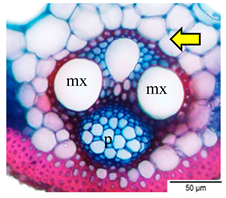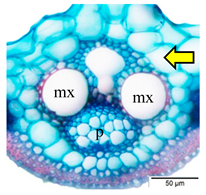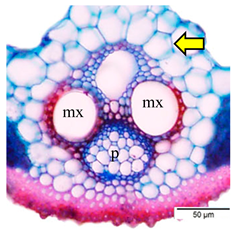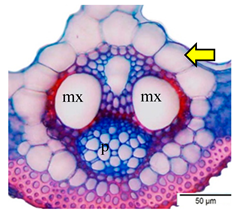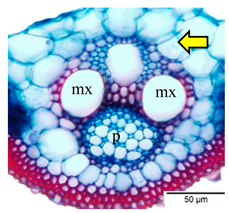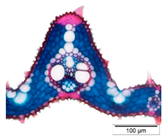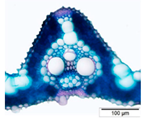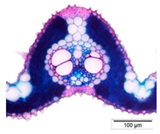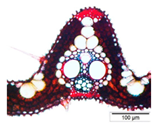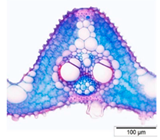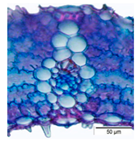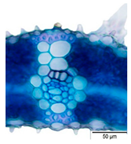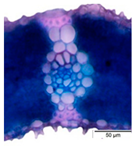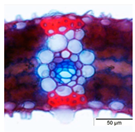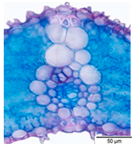Abstract
Bacterial leaf streak (BLS) caused by bacterium Xanthomonas oryzae pv. oryzicola (Xoc) is one of the most prominent rice diseases. BLS causes a significant reduction in paddy yields. However, there are limited studies and a lack of information regarding the mechanisms and cells affected on leaf tissues severed from this disease. Therefore, in this study, sensitive paddy variety IR24 was inoculated against BLS, and the pathogen colonised mesophyll cells and some bundle sheath cells. The infection spreads rapidly towards the base and apex of the leaf, but rather slowly to the left and right sides of the leaf veins. Another experiment was performed to unravel anatomical characteristics in sensitive paddy varieties (TN1, IR24, IR5) and resistant paddy varieties (IR26, Dular, IR36) against BLS. Susceptible paddy varieties have less thick midrib and leaf lamina, a high number of bundle sheath cells at primary vascular tissue (midrib), one layer of sclerenchyma cells at the secondary vein, and more than two metaxylems at the primary vein. Resistant paddy varieties, on the other hand, consist of a relatively thickened midrib and leaf lamina, fewer bundle sheath cells at the primary vascular tissue (midrib), more than one sclerenchyma layers at the secondary vein, and two metaxylems at the primary vein. This study contributes new knowledge in identifying the level of infection in paddy fields, and helps breeders in producing resistant paddies to this disease.
1. Introduction
Oryza sativa L. or paddy rice is the leading staple food in Asia. However, paddy rice yields can fluctuate due to numerous factors such as pests or diseases. Bacterial diseases are significant constraints to rice production in Africa, and several humid tropical and subtropical areas of Asia [1]. Bacterial diseases are most destructive and cause significant yield loss [2]. Among them, the most prevalent diseases are bacterial leaf blight (BLB) and bacterial leaf streak (BLS) caused by Xanthomonas oryzae pv. oryzae (Xoo) and Xanthomonas oryzae pv. oryzicola (Xoc), respectively [3]. BLB and BLS can spread on paddy plants and reduce rice yield [4]. However, both bacteria are too difficult to distinguish morphologically and genetically [4,5,6]. Both Xanthomonas species have 90% similarity by DNA:DNA hybridisation [7].
From 1993 to 1998, a survey was conducted in Zhejiang, China (subtropical) and Luzon, Philippines (tropical) to identify the rice disease and its causal bacteria. A total of 3500 isolates of infected paddy plants conclusively showed that there are 208 pathogenic bacterial isolates screened, and Xanthomonas oryzae pv. oryzicola were the most common bacteria in the two areas [8]. There are several recent studies investigating BLS in Africa, as reported in Senegal, Nigeria, Madagascar, and Mali [9]. Previous research showed the early stage paddy symptoms in Burkina Faso in October 2009, where this disease is commonly spotted on wild rice species (O. longistaminata and O. barthii), cultivated Oryza sativa (TS2, FKR19, and FKR56N), and weeds [9]. In October 2013, Vietnamese researchers found a high prevalence of bacterial leaf diseases in the irrigated rice fields of the Red River delta (western coast of the Gulf of Tonkin) [10]. BLS symptoms were reported in some rice varieties in several states of Malaysia from March 2014 to May 2015, and 99% of all isolates were identical to Xoc strain NCPPB3949 isolated back in 1956 [11]. Several studies attempted to explain the yield effect of the disease on rice production. A report showed that the disease reduced crop yield production losses by up to 32% (under favourable conditions) [12,13].
Xoc is a Gram-negative bacterium with rod-shaped, round-ended, one-end flagella that is a member of the gamma subdivision of the Proteobacteria class [7,13]. This pathogen is prevalent in regions with high humidity and warm temperatures. It can be transmitted by infected seeds from one summer to another summer without being interrupted by the winter season, as the pathogen become inactive during winter [12]. This pathogen was colonised and proliferated in the plant’s apoplast of mesophyll parenchyma cells [14]. One of the recommendations for BLS management is to plant resistant rice varieties against the disease [15]. Thus, understanding the mechanism of plant–microbe interactions is needed to elucidate resistance factors in plants.
Host recognition by a microbe is also an essential aspect of host–pathogen interactions. Therefore, we applied the anatomical method in investigating interactions and identifying the exclusive characteristics of resistant varieties towards BLS. The anatomical approach was used in systematics and taxonomy classification [16,17,18,19]. As reported, numerous characters are used to differentiate plant species or subspecies, such as variation in petioles [20,21]], leaf venation [22], and stipe [23]. For that reason, this study aimes to decipher disease progression and discover potential resistance characteristics between rice cultivars towards Xanthomonas oryzae pv. oryzicola using the anatomical approach.
2. Materials and Methods
2.1. Study Site
The study was conducted in the PC2-Certified Greenhouse (RTPC2) at the Institute of Systems Biology, Universiti Kebangsaan Malaysia (UKM). The soil used for planting was a combination of soil, sand, and organic manure with a ratio of 3:2:1. Seeds of six paddy varieties (TN1, IR24, IR5, IR36, Dular, and IR26) were soaked in water, drained, and germinated for 24 h until their radicals emerged from the seeds. Seeds were then transferred to plastic pots with cotton and constantly kept moisturised before transplanting. After 10 days of sowing, seedlings were transplanted into the pots. All plants were grown under controlled conditions at 28 °C, 12 h day and 12 h night, with watering every 2 days (1–2 cm water depth).
2.2. Variety Selection
IR24 was evaluated against Xanthomonas oryzae pv. oryzicola (Xoc) in a PC2-Certified Greenhouse, under controlled conditions at 28 °C. Then, IR24 and 5 more varieties (IR5, IR26, IR36, Dular and TN1) were selected to investigate the variation in anatomical characters in susceptible and resistant varieties. Plant materials were selected on the basis of the International Rice Research Institute (IRRI). Malaysian Agriculture Research and Development Institute (MARDI), Serdang Selangor provided the plant seeds used in this study.
2.3. Pathogen and Inoculum Preparation
Xanthomonas oryzae pv. oryzicola (Xoc) used in this study was provided by MARDI Serdang, Selangor. The strain was stored in 15% glycerol at −80 °C. Xoc was grown on potato sucrose agar (sucrose 20 g/L, peptone 5 g/L, calcium nitrate 0.5 g, sodium phosphate 0.82 g/L and agar 17 g/L) for 24 h at 28 °C. The bacteria were then resuspended in nutrient broth and diluted to approximately 1 × 108 CFU mL−1 at an optical density of 0.10 and a wavelength of 600 nm using a spectrophotometer. Mechanical inoculation was conducted using a pipette. Each drop contained 1 μL of bacteria suspension; a pipette was used to transfer drops onto the leaves. Bacteria were inoculated at the vegetative stage of plants (Day 30). The experiment was repeated three times.
2.4. Data Collection and Analysis
Lesions induced by Xoc on paddy genotype leaves were measured three days after inoculation using a 300 mm calibrated ruler. Obtained data were analysed using the one-way analysis of variance (ANOVA) t-test in IBM SPSS 26 software. In addition, BLS severity was recorded and analysed continuously for 20 days after inoculation (DAI) (2, 6 10, 13, 17 and 20 DAI) using a progressive 1–9 scale (Table 1) [24].

Table 1.
Disease rating scale and percentage of leaf area covered with bacterial leaf streak.
2.5. Anatomy of Infected Leaves IR24, Sensitive and Resistant Varieties
The cross- and transverse sections were cut by hand with a thickness of 25 µm using a sliding microtome (Leica SM 2000 R). Sections were then stained with safranin and Alcian blue for 5–10 min. Alcian blue and safranin were used to detect the presence of pectins (and other acidic polysaccharides, including mucilages) and to stain lignified tissues such as xylem [25,26]. This was followed by dehydration in a graded ethanol series (50%, 75%, 90% and 100%), and slides were mounted in Eupharal [27]. Anatomical leaf features were observed using an Olympus BX34 DP72 camera and a Canon EOS 700D. Anatomical structures were captured and analysed using Analysis Docu and EOS Utility 2 software. Photographs of leaf cells were studied at four different objective magnifications (4×, 10×, 20×, and 40×). According to Mutka et al. [28], the percentage of the infected area can be calculated on the basis of the following formula to observe disease progression in infected leaves:
- (i)
- Percentage of infected area = total width of infected area/total width of entire studied area × 100.
- (ii)
- Percentage of stain absorption (colour absorption) = total width of coloured area (infected)/total width of entire studied area × 100.
Healthy and infected leaves were compared to identify their differences.
3. Results
3.1. Disease Progression in IR24
Paddy leaves were long and flattened for the healthy plant sample (control), which comprised 11 to 12 parallel veins per leaf, and it was 88.9 cm in length and 12.5 cm wide on average. Although lesions started to appear within 2–3 days of infection and spread in parallel to veins, no lateral spread was found. Therefore, BLS severity was recorded and analysed continuously (2, 6 10, 13, 17, and 20 DAI) using a progressive 1–9 scale (Table 1).
Leaves on the second day were assigned Scale 2 with infections spreading only in the leaf area at the inoculation site (Figure 1; yellow arrow), 1–5% of the total leaf area. Leaves on the sixth day were assigned Scale 3, with the infection area representing 6–20% of the total leaf area (Figure 1; green arrow). The infection spread from the inoculation area to the leaves’ left side, then to the apex and base, while the right side was still intact. Leaves on day 10 were assigned Scale 5, showing the infection covering a leaf area of up to 21–40%, and elongated in parallel to the leaf veins. Infection was found at one-third of the leaf apex compared to the middle or leaf base (Figure 1; blue arrow). Leaves on day 13 were assigned Scale 7, as the infection had already spread to two-thirds of the leaves. The estimated disease area was 41–50% (Figure 1; grey arrow). Leaves on day 17 were assigned Scale 8, with the infection covering 51–75% of leaves (Figure 1; orange arrow). The infected area (shown as the yellow region in Figure 1) dominated the leaf area and decreased the healthy leaf area (shown as the green region in Figure 1). Leaves on day 20 were assigned Scale 9, where the infection area covered >75% of the leaf area. The left and right sides of leaves began to roll, affected by dead cells (Figure 1, red arrow). Leaves infected by bacteria turned white and grey, possibly due to the growth of saprophyte fungi that developed into bacterial mite disease. A similar result was reported by Rudolph [29]. Figure 1 shows the infection progress with the disease severity scale in IR24.
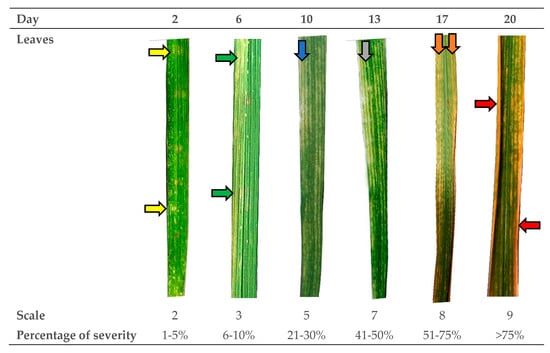
Figure 1.
Disease development of bacterial leaf streak in IR24; 1 = no lesions to small brown specks of pinhead size (0.1–1.0 mm), less than 1% leaf area affected; 2 = typical BLS lesions covering 1–5% leaf area covered with lesions; 3 = 6–10%; 4 = 11–20%; 5 = 21–30%; 6 = 31–40%; 7 = 41–50%; 8 = 51–75% and many leaves dead; and 9 = typical BLS lesions covering >75% leaf area or all leaves dead [24]; yellow, green, blue, grey, and orange arrows = infection area; red arrow = leaf roll.
3.2. Anatomical Analysis of Infected IR24
3.2.1. Mesophyll Cell Analysis
In healthy leaves (Stage 1), three layers of mesophyll cells were observed, with ten mesophyll cells arranged horizontally between two veins (Figure 2). The total number of mesophyll cells was ∼30 cells and in a normal state. Mesophyll cells at Stage 2 began to lose shape; more than half of the mesophyll cells collapsed and could not be identified. Normal mesophyll cells declined to ∼30%. The ratio of length and width of the area between veins was 6:1. In Stage 3, the infected area lost its original state, and no mesophyll cells could be seen in the area, even though the epidermis layers were still intact (Figure 3, Stage 3). At this stage, mesophyll cells were unrecognisable and fully degenerated, and the ratio of length to width was 7:1.
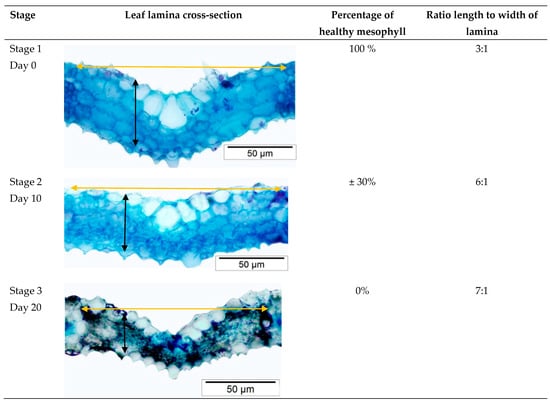
Figure 2.
Degeneration of mesophyll cells at three different stages. Black arrow: width of mesophyll; yellow arrow: length of mesophyll.
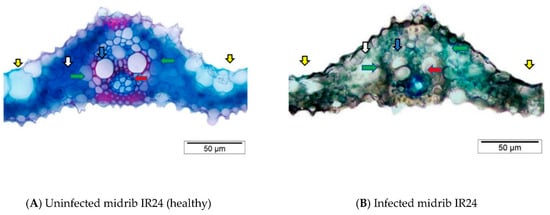
Figure 3.
Midrib cross-section of IR24. (A): uninfected midrib; (B): infected midrib; yellow arrow: bulliform cell; white arrow: mesophyll cells; blue arrow: metaxylem; green arrow: bundle sheath cell; and red arrow: phloem.
3.2.2. Comparison of Healthy and Infected Midrib of IR24
Mesophyll cells were entirely affected after ten days of infection. Figure 3A,B show healthy and infected midrib, respectively. Vascular tissue, especially the metaxylem, was multiplied, and even mesophyll cells were not recognisable. In contrast, companion cells in phloem tissue were destroyed, with sieve tubes still being identifiable (Figure 3B). The sheath of several bundles could not be identified, and bulliform cells were also affected. Sclerenchyma cells could still be identified despite not absorbing the stain. A translucent area in the infected midrib showed that chlorophyll was totally depleted. Table 2 shows differences in structure and stain absorption between uninfected (healthy) IR24 and infected midrib of IR24.

Table 2.
Differences in structure and stain absorption between healthy and infected by Xoc IR24 midrib.
3.3. Comparative Anatomical Features of Resistant and Sensitive Paddy Varieties
3.3.1. Midrib
Resistant paddy varieties IR36, Dular, and IR26 had midrib thickness of ∼328.92, ∼321.79, and ∼263.92 µm, respectively. Results showed that there was a difference in midrib thickness between sensitive and resistant paddy groups. Midrib was thicker in the resistant paddy group, and the TN1 variety had the thickest midrib of ∼409.09 µm, while the two other sensitive paddy varieties, IR24 and IR5, had ∼248.44 and ∼205.41 µm, respectively. In addition, there were differences between the susceptible and resistance group varieties in the number of bundle sheaths that surround primary vascular bundles. The sensitive group had more cell layers (TN1, ∼26 cells; IR24, ∼29 cells; and IR5, ∼23 cells) compared to the number of bundle sheaths present in the resistant group of IR36, Dular, and IR26, which had ∼22 cells each. Table 3 shows the number of bundle sheath cells in the midrib’s primary vascular bundles of the resistant and sensitive varieties. All varieties found in this study had the same number of lacunae (four) and a presence of trichomes, including papillae. The presence of a parenchyma cell extension and the number of sclerenchyma cell layers in the midrib did not show significant differences.

Table 3.
Variety in number of bundle sheath cells in resistant and sensitive paddy varieties.
3.3.2. Lamina
Laminar thickness in TN1 was ∼78.33, IR24 ∼59.67, and IR5 ∼63.83 µm; in the sensitive paddy group, it was ∼72.22 µm for IR36, ∼69.79 µm for Dular, and ∼66.57 µm for IR26. There were several primary veins in the leaf lamina, and more than two metaxylems were present, with more abundance in susceptible paddy varieties. The metaxylem was exceeded in TN1, IR24, and IR5 (63.6%, 63.6%, and 54.5%); in the IR36, Dular, and IR26 resistance groups, it was 33.33%, 42.86% and 40%, respectively (Table 4).

Table 4.
Variation in percentage of metaxylem > 2 and ratio of metaxylem > 2 to metaxylem = 2 (primary vein) of sensitive and resistant paddy varieties.
The number of sclerenchyma cell layers was different in the resistant and sensitive paddy varieties, especially in secondary veins. Secondary veins were located within primary veins. There were four or five secondary veins attached to the interval of one primary vein. One layer of sclerenchyma cells was found in susceptible varieties TN1, IR24, and IR5. The ratio of secondary veins having one sclerenchyma layer to secondary veins having more than one sclerenchyma layer for TN1, IR24 and IR5 was 3:2, while for IR36, Dular and IR26, it was 1:4, 2:3, and 2:3 (Table 5).

Table 5.
Variation in number of sclerenchyma cells layers in sensitive and resistant paddy varieties.
All studied varieties had trichomes present on the abaxial and adaxial leaf epidermis. However, there were a few inconsistent features in the sensitive and resistant paddy varieties, such as the number of bundle sheath cells at secondary veins, the number of sclerenchyma cell layers at primary veins, the distance between bundle sheath cells, and the distance between vascular bundles. Statistical analysis revealed that laminar thickness, the number of metaxylems, the number of sclerenchyma layers, and the number of bundle sheath cells were significantly different at p 0.05 between susceptible and resistant varieties. On the other hand, midrib thickness did not exhibit any significant difference at p > 0.05. Table 6 shows the variation in anatomical features between BLS-resistant and -sensitive paddy varieties.

Table 6.
Variation in anatomical characteristics between sensitive and resistant paddy varieties towards bacterial leaf streak.
4. Discussion
4.1. Disease Progression in IR24
Xoc penetrates the leaf through wounded areas or natural openings such as stomata [13]. Once bacteria actively or passively reach the substomatal space, they multiply before symptoms start to appear. Most Xoo or Xoc strains that successfully enter mesophyll cells can cause waterborne infections (water-soaked lesions) within days 3–7 of susceptible varieties; the leaf turns yellow and is surrounded by brownish spots [30,31]. After a few days, lesions are elongated in parallel to the leaf vein. The infection process continues along the vein and spreads slowly to the left and right sides of the leaf [1]. On day 20, the infection worsens, with dead cells visible on the leaves.
As a biotrophic pathogen, Xanthomonas derives its nutrients from host cells; therefore, BLS disease takes time to appear on the leaf, and disease development appears to be slower compared to other diseases such as blast, which only takes nine days to reach scale 9 [24,32].
Safranin and Alcian blue staining revealed mesophyll cells between adaxial and abaxial epidermal layers. Since mesophyll cells are attached to cell wall fixtures, Xoc needs to break down cell walls attached to lobes and then penetrate mesophyll cells. Although Xoo and Xoc can multiply in the space between mesophyll cells, only Xoc can break cell wall fixtures between mesophyll cells to spread within the area between cells and thereby cause infection [30].
The cell wall is a relatively difficult barrier for plant pathogens to penetrate. Therefore, the ability to break down the wall barrier is a crucial feature of plant pathogenic bacteria. The degradation of cell walls produces a signal of infection in plants as a damage-associated molecular pattern (DAMP) process that results in the activation of a potent innate immune response [33,34,35]
Some cells, however, do not contain chloroplasts and can still become infected with this pathogen. These could be triggered due to the plants’ hypersensitive response (HR) that occurs when pathogens penetrate the plant tissues. The HR activates responses that suppress the resistance response. Nevertheless, this can only happen if a pathogen is able to suppress the plant’s immune system [31]. HR is a deliberate plant cell suicide system at the site of infection that prevents pathogens from continuously acquiring water and nutrients at any infected cells to spare other healthy and uninfected plant tissues. Different to a typical plant defence system, HR is usually more specific to the pathogen and only occurs when proteins in plant cells detect the presence of specific disease-causing effector molecules carried by the pathogen into the host.
This response results in water stress, which explains the deterioration of bulliform cells in the infected midrib found in the adaxial epidermis of leaves and in vascular bundles (xylem and phloem) [36,37]. Bulliform cells appear intercostally as long, broad stripes. In paddies, they are arranged in groups of multiple cells, with clusters not being next to one another [38]. Generally, in lack of water, bulliform cells lose their vigour (turgor) and induce adaxial leaf curling due to a change in osmotic pressure. When there is sufficient water, bulliform cells reabsorb water and become turgid again, resulting in leaves reopening [39,40].
On the other hand, the metaxylem continues to divide even when the plant is infected. To date, there is still no study on the xylem division response to pathogenic infections, which shows any infiltration to the vascular system. Xoc tends to colonise parenchyma rather than vascular tissue, which is why xylem and phloem do not show significant deterioration [30].
4.2. Comparative Anatomical Characteristics of Resistant and Sensitive Paddy Varieties
Information on resistance genes against BLS found in rice remains scarce [41]. For instance, gene X01 confers resistance only towards African strains of Xoc and not Asian strains [42]. Hence, the discovery of potential characters in resistant varieties through anatomical methods is necessary to add value to information on germplasm screening towards bacterial leaf streak.
This study showed that resistant paddy varieties have thicker leaf lamina, larger-lobed mesophyll cells, and wider cell wall surfaces than those of susceptible paddy varieties. In addition, differences in metaxylem number and sclerenchyma cell thickness were also reported. Lignin is the major component of the metaxylem and sclerenchyma cells. The lignin layer beneath the epidermis provides a better resistance effect than that of the lignin present in vascular tissue. Lignin under the epidermal layer is the first barrier in preventing the entry of pathogens into the leaves. Lignification was proposed as an essential mechanism in wheat resistance to diseases caused by various fungal pathogens when no phytoalexins are found in wheat Triticum aestivum L. [43]. In wheat, lignin acts as a defensive response during infection. For example, S-enriched lignin accumulates during hypersensitive reactions by wheat due to Puccinia graminis infection [44], and is synthesised in wheat epidermal cells infected with Fusarium proliferatum [45]. Lignin and phenolic polymers (which look most like lignin) accumulate in plant cell walls in response to biotic and abiotic stresses, and invasions to their structures [46].
Sensitive paddy varieties have more bundle sheath cells compared to resistant paddy varieties. However, to our knowledge, none of these previous studies explains how the bundle sheath of C3 plants is preferentially related to sensitiveness to disease.
5. Conclusions
Our study focused on the mechanisms and cells impacted by Xoc’s BLS disease on leaf tissues of the IR24 paddy variety. Pathogens successfully colonised mesophyll cells and a certain bundle of sheath cells. The infection rapidly spread perpendicular to the base and apex of the leaf, but rather slowly towards both sides of the leaf veins. Anatomical characteristics between susceptible (TN1, IR25, IR5) and resistant (IR26, Dular, IR36) paddy varieties against BLS were compared. Resistant and sensitive paddy varieties can be distinguished by midrib thickness characteristics and the number of bundle sheath cells in the main vascular bundle. While the difference between resistant and susceptible paddy varieties in primary veins is determined by the leaf laminar thickness and the number of metaxylems, the difference between resistant and susceptible paddy varieties in secondary veins is determined by the number of sclerenchyma layers. Understanding the level of pathogen infection in paddy rice assists researchers in solving this issue and breeders in developing paddy varieties that are resistant to the disease.
Author Contributions
Conceptualisation, N.T. and H.B.; methodology, W.A.W. and S.B.; formal analysis, N.T., H.B. and W.A.W.; writing—draft preparation, review, and editing, S.B., M.A.A., M.F.M.S., W.A.W., N.T. and H.B. All authors have read and agreed to the published version of the manuscript.
Funding
The authors would like to thank the Ministry of Higher Education of Malaysia for providing us funding (FRGS/1/2019/STG03/UKM/02/3) for this research.
Institutional Review Board Statement
Not applicable.
Informed Consent Statement
Not applicable.
Data Availability Statement
All data are available in the paper.
Acknowledgments
We would like to thank the Faculty of Science and Technology, Universiti Kebangsaan Malaysia for the instruments and facilities used for this research.
Conflicts of Interest
The authors declare no conflict of interest.
References
- Nino-Liu, D.O.; Ronald, P.C.; Bogdanove, A.J. Xanthomonas oryzae pathovars: Model pathogens of a model crop. Mol. Plant Pathol. 2006, 7, 303–324. [Google Scholar] [CrossRef]
- Org, E.; Kumar, S.; Meshram, S.; Sinha, A. Bacterial Diseases in Rice and Their Eco-Friendly Management. Int. J. Agric. Sci. Res. IJASR 2017, 7, 31–42. [Google Scholar]
- Soto-Suarez, M.; Gonzalez, C.; Piegu, B.; Tohme, J.; Verdier, V. Genomic comparison between Xanthomonas oryzae pv. oryzae and Xanthomonas oryzae pv. oryzicola, using suppression-subtractive hybridization. FEMS Microbiol. Lett. 2010, 308, 16–23. [Google Scholar] [CrossRef]
- Tian, Y.; Zhao, Y.; Xu, R.; Liu, F.; Hu, B.; Walcott, R.R. Simultaneous detection of Xanthomonas oryzae pv. oryzae and X. oryzae pv. oryzicola in rice seed using a padlock probe-based assay. Phytopathology 2014, 104, 1130–1137. [Google Scholar] [CrossRef]
- Goto, M. Fundamentals of Bacterial Plant Pathology; Academic Press Inc.: San Diego, CA, USA, 1992. [Google Scholar]
- Mew, T.W.; Alvarez, A.M.; Leach, J.E.; Swings, J. Focus on Bacterial Blight of Rice. Plant Dis. 1993, 77, 5–12. [Google Scholar] [CrossRef]
- Swings, J.; Van Den Mooter, M.; Vauterin, L.; Hoste, B.; Gillis, M.; Mew, T.W.; Kersters, K. Reclassification of the causal agents of bacterial blight (Xanthomonas campestris pv. oryzae) and bacterial leaf streak (Xanthomonas campestris pv. oryzicola) of rice as pathovars of Xanthomonas oryzae (ex Ishiyama 1922) sp. nov., nom. rev. Int. J. Syst. Bacteriol. 1990, 40, 309–311. [Google Scholar] [CrossRef]
- Xie, G.L.; Mew, T.W. A leaf inoculation method for detection of Xanthomonas oryzae pv. oryzicola from rice seed. Plant Dis. 1998, 82, 1007–1011. [Google Scholar] [CrossRef]
- Wonni, I.; Ouedraogo, L.; Verdier, V. First report of bacterial leaf streak caused by Xanthomonas oryzae pv. oryzicola on rice in Burkina Faso. Am. Phytopathol. Soc. 2011, 95, 72. [Google Scholar] [CrossRef] [PubMed]
- Tran, T.; Nga, N.; Ngan, P.; Hong, N.; Szurek, B.; Koebnik, R.; Huy, L.; Cuong, V.; Cunnac, S. Confirmation of bacterial leaf streak of rice caused by Xanthomonas oryzae pv. oryzicola in Vietnam. Plant Dis. 2015, 99, 1853. [Google Scholar] [CrossRef]
- Hata, E.M.; Sijam, K.; Yusof, M.T.; Zulperi, D. Occurrence of Xanthomonas oryzae pv. oryzicola causing bacterial leaf streak disease of rice in different state of Malaysia. J. Plant Pathol. 2019, 101, 785–786. [Google Scholar] [CrossRef]
- Sukchawalit, R.; Mongkolsuk, S. Xanthomonas oryzae pv. oryzae recA is transcribed and regulated from multiple promoters. FEMS Microbiol. Lett. 2001, 197, 35–40. [Google Scholar] [CrossRef] [PubMed][Green Version]
- Wang, L.; Makino, S.; Subedee, A.; Bogdanove, A.J. Novel candidate virulence factors in rice pathogen Xanthomonas oryzae pv. oryzicola as revealed by mutational analysis. Appl. Environ. Microbiol. 2007, 73, 8023–8027. [Google Scholar] [CrossRef] [PubMed]
- Cai, L.; Cao, Y.; Xu, Z.; Ma, W.; Zakria, M.; Zou, L.; Cheng, Z.; Chen, G. A Transcription Activator-Like Effector Tal7 of Xanthomonas oryzae pv. oryzicola Activates Rice Gene Os09g29100 to Suppress Rice Immunity. Sci. Rep. 2017, 7, 5089. [Google Scholar] [CrossRef] [PubMed]
- He, W.; Huang, D.; Li, R.; Qiu, Y.; Song, J.; Yang, H.; Zheng, J.; Huang, Y.; Li, X.; Liu, C.; et al. Identification of a resistance gene bls1 to bacterial leaf streak in wild rice Oryza rufipogon griff. J. Integr. Agric. 2012, 11, 962–969. [Google Scholar] [CrossRef]
- Aladdin, N.-A.; Jamal, J.A.; Talip, N.; Husain, K.; Jalil, J. Comparative study of three Marantodes pumilum varieties by microscopy, spectroscopy and chromatography. Rev. Bras. Farmacogn. 2016, 26, 1–14. [Google Scholar] [CrossRef]
- Maideen, H.; Hazwani, A.N.; Nurfarahain, Z.; Damanhuri, A.; Noraini, T.; Rusea, G.; Qistina, L.; Masnoryante, M. Systematic significance of stipe anatomy of Selaginella (Selaginellaceae) in peninsular Malaysia. Sains Malays. 2013, 42, 693–696. [Google Scholar]
- Noraini, T.; Amirul-Aiman, A.J.; Jaman, R.; Damanhuri, A.; Ruzi, A.R. Systematic significance of stipe anatomy in peninsular Malaysian Blechnum L. (Blechnaceae) species. Malays. Appl. Biol. 2014, 43, 119–128. [Google Scholar]
- Talip, N.; Hussin, K.H.; Ibrahim, H. Comparative leaf anatomy of Alpinia species (Zingiberaceae) in Malaysia. Nord. J. Bot. 2003, 23, 463–483. [Google Scholar] [CrossRef]
- Noraini, T.; Ruzi, A.R.; Ismail, B.S.; Salwa, S.; Azeyanty, J.A. Petiole vascular bundles and its taxonomic value in the tribe Dipterocarpeae (Dipterocarpaceae). Sains Malays. 2016, 45, 247–253. [Google Scholar]
- Talip, N.; Cutler, D.F.; Ahmad Puad, A.S.; Ismail, B.S.; Ruzi, A.R.; Ahmad Juhari, A.A. Diagnostic and systematic significance of petiole anatomy in the identification of Hopea species (Dipterocarpaceae). S. Afr. J. Bot. 2017, 111, 111–125. [Google Scholar] [CrossRef]
- Badron, U.H.; Talip, N.; Mohamad, A.L.; Affenddi, A.E.A.; Juhari, A.A.A. Studies on leaf venation in selected taxa of the genus Ficus l. (Moraceae) in Peninsular Malaysia. Trop. Life Sci. Res. 2014, 25, 111–125. [Google Scholar] [PubMed]
- Noraini, T.; Ruzi, A.R.; Nadiah, N.; Maideen, H.; Solihani, S.N. Stipe anatomical characteristics in some Davallia (Davalliaceae) species in Malaysia. Sains Malays. 2012, 41, 53–62. [Google Scholar]
- Babu, T.K.; Thakur, R.P.; Upadhyaya, H.D.; Reddy, P.N.; Sharma, R.; Girish, A.G.; Sarma, N.D.R.K. Resistance to blast (Magnaporthe grisea) in a mini-core collection of finger millet germplasm. Eur. J. Plant Pathol. 2013, 135, 299–311. [Google Scholar] [CrossRef]
- Ohdaira, Y.; Kakegawa, K.; Amino, S.; Sugiyama, M.; Fukuda, H. Activity of cell wall degradation associated with differentiation of isolated mesophyll cells of Zinnia elegans into tracheary elements. Planta 2002, 215, 177–184. [Google Scholar] [CrossRef] [PubMed]
- Bond, J.; Donaldson, L.; Hill, S.; Hitchcock, K. Safranine fluorescent staining of wood cell walls. Biotech. Histochem. 2008, 83, 161–171. [Google Scholar] [CrossRef] [PubMed]
- Noraini, T.; Mohamad Ruzi, A.R.; Muhammad Amirul Aiman, A.J. Anatomi dan Mikroskopik Tumbuhan; Penerbit Universiti Kebangsaan Malaysia: Bangi, Malaysia, 2019; pp. 30–36. [Google Scholar]
- Mutka Andrew, M.; Bart Rebecca, S. Image-based phenotyping of plant disease symptoms. Front. Plant Sci. 2015, 5, 734. [Google Scholar]
- Rudolph, K. Infection of the Plant by Xanthomonas. In Xanthomonas, 1st ed.; Swings, J.G., Civerolo, E.L., Eds.; Chapman and Hall: London, UK, 1993; pp. 193–264. [Google Scholar]
- Cao, J.; Chu, C.; Zhang, M.; He, L.; Qin, L.; Li, X.; Yuan, M. Different cell wall-degradation ability leads to tissue-specificity between Xanthomonas oryzae pv. oryzae and Xanthomonas oryzae pv. oryzicola. Pathogens 2020, 9, 187. [Google Scholar] [CrossRef]
- Tabei, H. Anatomical studies of rice plant affected with bacterial leaf blight, with special reference to stomatal infection at the coleoptile and the foliage leaf sheath of rice seedling. Jpn. J. Phytopathol. 1967, 33, 12–16. [Google Scholar] [CrossRef]
- Freeman, B.C.; Beattie, G.A. An overview of plant defenses against pathogens and herbivores an overview of plant defenses against pathogens and herbivores. Plant Health Instr. 2008, 94. [Google Scholar] [CrossRef]
- Darvill, A.G.; Albersheim, P. Phytoalexins and their elicitors—A defense against microbial infection in plants. Annu. Rev. Plant Physiol. 1984, 35, 243–275. [Google Scholar] [CrossRef]
- Ryan, C.A.; Farmer, E.E. Oligosaccharide signals in plants: A current assessment. Annu. Rev. Plant Physiol. Plant Mol. Biol. 1991, 42, 651–674. [Google Scholar] [CrossRef]
- Sinha, D.; Gupta, M.K.; Patel, H.K.; Ranjan, A.; Sonti, R.V. Cell wall degrading enzyme induced rice innate immune responses are suppressed by the type 3 secretion system effectors XopN, XopQ, XopX and XopZ of Xanthomonas oryzae pv. oryzae. PLoS ONE 2013, 8, e75867. [Google Scholar] [CrossRef] [PubMed]
- Botwright, T.L.; Rebetzke, G.J.; Condon, A.G.; Richards, R.A. Influence of the gibberellin-sensitive Rht8 dwarfing gene on leaf epidermal cell dimensions and early vigour in wheat (Triticum aestivum L.). Ann. Bot. 2005, 95, 631–639. [Google Scholar] [CrossRef] [PubMed]
- Fujino, K.; Matsuda, Y.; Ozawa, K.; Nishimura, T.; Koshiba, T.; Fraaije, M.W.; Sekiguchi, H. NARROW LEAF 7 controls leaf shape mediated by auxin in rice. Mol. Genet. Genom. 2008, 279, 499–507. [Google Scholar] [CrossRef]
- Kim, H.; Du, X.; Kim, S.; Kim, P.; Wijesinghe, R.E.; Yun, B.; Kim, K.; Jeon, M.; Kim, J. Non-Invasive Morphological Characterization of Rice Leaf Bulliform and Aerenchyma Cellular Regions Using Low Coherence Interferometry. Appl. Sci. 2019, 9, 2104. [Google Scholar] [CrossRef]
- Li, L.; Shi, Z.Y.; Li, L.; Shen, G.Z.; Wang, X.Q.; An, L.S.; Zhang, J.L. Overexpression of ACL1 (abaxially curled leaf 1) increased bulliform cells and induced abaxial curling of leaf blades in rice. Mol. Plant 2010, 3, 807–817. [Google Scholar] [CrossRef]
- Price, A.H.; Young, E.M.; Tomos, A.D. Quantitative trait loci associated with stomatal conductance, leaf rolling and heading date mapped in upland rice (Oryza sativa L.). New Phytol. 1997, 137, 83–91. [Google Scholar] [CrossRef]
- Jiang, N.; Yan, J.; Liang, Y.; Shi, Y.; He, Z.; Wu, Y.; Peng, J. Resistance genes and their interactions with bacterial blight/leaf streak pathogens (Xanthomonas oryzae) in rice (Oryza sativa L.)—An updated review. Rice 2020, 13, 3. [Google Scholar] [CrossRef]
- Triplett, L.R.; Cohen, S.P.; Heffelfinger, C.; Schmidt, C.L.; Huerta, A.; Tekete, C.; Verdier, V.; Bogdanove, A.J.; Leach, J.E. A resistance locus in the American heirloom rice variety Carolina gold select is triggered by TAL effectors with diverse predicted targets and is effective against African strains of Xanthomonas oryzae pv. oryzicola. Plant J. 2016, 87, 472–483. [Google Scholar] [CrossRef]
- Grand, C. Ferulic acid 5-hydroxylase: A new cytochrome P-450-dependent enzyme from higher plant microsomes involved in lignin synthesis. FEBS Lett. 1984, 169, 7–11. [Google Scholar] [CrossRef]
- Menden, B.; Kohlhoff, M.; Moerschbacher, B.M. Wheat cells accumulate a syringyl-rich lignin during the hypersensitif resistance response. Phytochemistry 2007, 68, 513–520. [Google Scholar] [CrossRef] [PubMed]
- Bishop, D.L.; Chyatterton, N.J.; Harrison, P.A.; Hatfeld, R.D. Changes in carbohydrate partitioning and cell wall remodeling with stress-induced pathogenesis in wheat sheaths. Physiol. Mol. Plant Pathol. 2002, 61, 53–63. [Google Scholar] [CrossRef]
- Sattler, S.; Funnell-Harris, D. Modifying lignin to improve bioenergy feedstocks: Strengthening the barrier against pathogens? Front. Plant Sci. 2013, 4, 70. [Google Scholar] [CrossRef] [PubMed]
Publisher’s Note: MDPI stays neutral with regard to jurisdictional claims in published maps and institutional affiliations. |
© 2022 by the authors. Licensee MDPI, Basel, Switzerland. This article is an open access article distributed under the terms and conditions of the Creative Commons Attribution (CC BY) license (https://creativecommons.org/licenses/by/4.0/).
